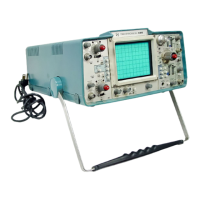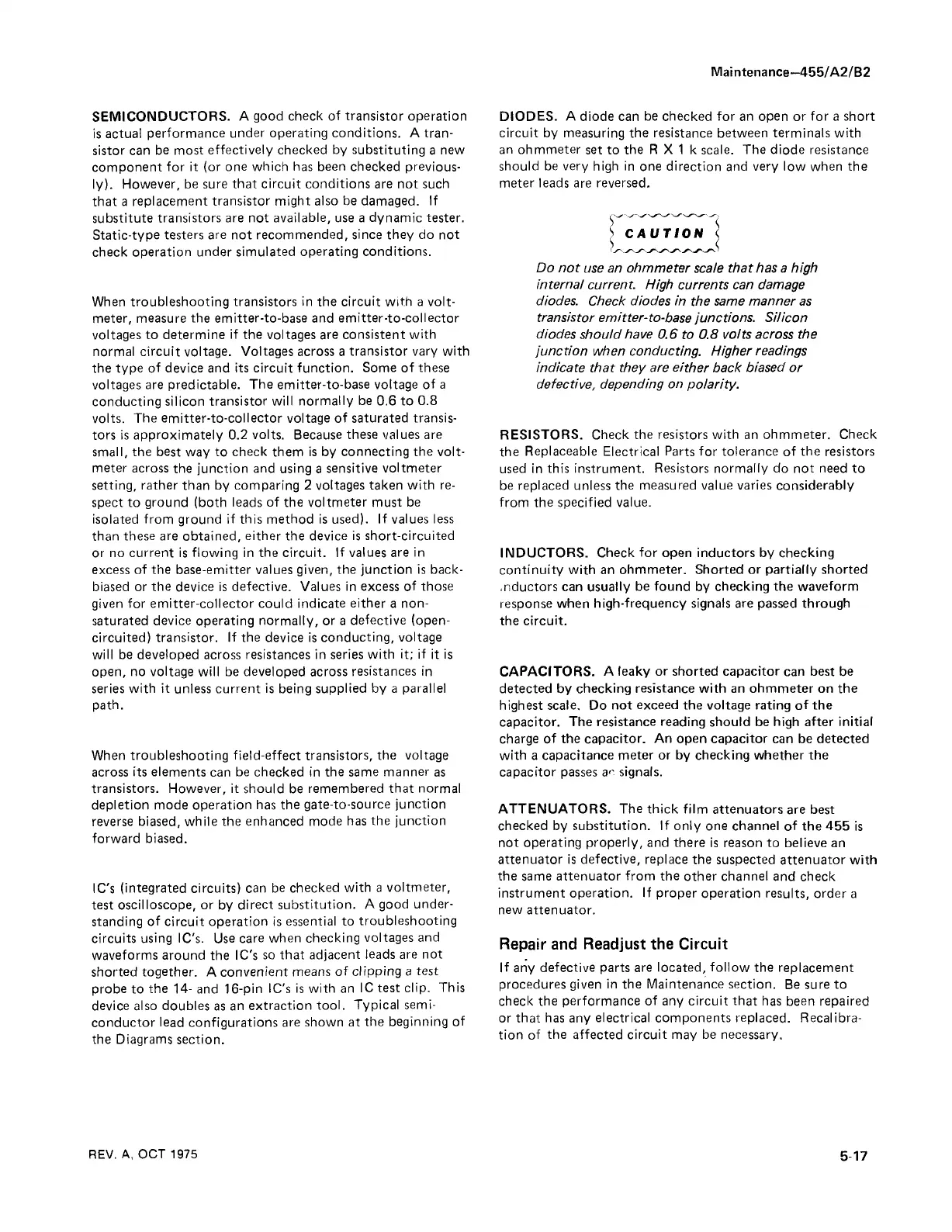Maintenance—455/A2/B2
SEMICONDUCTORS. A good check of transistor operation
is actual performance under operating conditions. A tran
sistor can be most effectively checked by substituting a new
component for it (or one which has been checked previous
ly). However, be sure that circuit conditions are not such
that a replacement transistor might also be damaged. If
substitute transistors are not available, use a dynamic tester.
Static-type testers are not recommended, since they do not
check operation under simulated operating conditions.
When troubleshooting transistors in the circuit with a volt
meter, measure the emitter-to-base and emitter-to-collector
voltages to determine if the voltages are consistent with
normal circuit voltage. Voltages across a transistor vary with
the type of device and its circuit function. Some of these
voltages are predictable. The emitter-to-base voltage of a
conducting silicon transistor will normally be 0.6 to 0.8
volts. The emitter-to-collector voltage of saturated transis
tors is approximately 0.2 volts. Because these values are
small, the best way to check them is by connecting the volt
meter across the junction and using a sensitive voltmeter
setting, rather than by comparing 2 voltages taken with re
spect to ground (both leads of the voltmeter must be
isolated from ground if this method is used). If values less
than these are obtained, either the device is short-circuited
or no current is flowing in the circuit. If values are in
excess of the base-emitter values given, the junction is back-
biased or the device is defective. Values in excess of those
given for emitter-collector could indicate either a non-
saturated device operating normally, or a defective (open-
circuited) transistor. If the device is conducting, voltage
will be developed across resistances in series with it; if it is
open, no voltage will be developed across resistances in
series with it unless current is being supplied by a parallel
path.
When troubleshooting field-effect transistors, the voltage
across its elements can be checked in the same manner as
transistors. However, it should be remembered that normal
depletion mode operation has the gate-to-source junction
reverse biased, while the enhanced mode has the junction
forward biased.
IC's (integrated circuits) can be checked with a voltmeter,
test oscilloscope, or by direct substitution. A good under
standing of circuit operation is essential to troubleshooting
circuits using IC's. Use care when checking voltages and
waveforms around the IC's so that adjacent leads are not
shorted together. A convenient means of clipping a test
probe to the 14- and 16-pin IC's is with an 1C test clip. This
device also doubles as an extraction tool. Typical semi
conductor lead configurations are shown at the beginning of
the Diagrams section.
DIODES. A diode can be checked for an open or for a short
circuit by measuring the resistance between terminals with
an ohmmeter set to the R X 1 k scale. The diode resistance
should be very high in one direction and very low when the
meter leads are reversed.
j> CAUTION <j
Do n o t use an ohmmeter scale that has a high
internal current. High currents can damage
diodes. Check diodes in the same manner as
transistor emitter-to-base junctions. Silicon
diodes should have 0.6 to 0.8 volts across the
junction when conducting. Higher readings
indicate that they are either back biased or
defective, depending on polarity.
RESISTORS. Check the resistors with an ohmmeter. Check
the Replaceable Electrical Parts for tolerance of the resistors
used in this instrument. Resistors normally do not need to
be replaced unless the measured value varies considerably
from the specified value.
INDUCTORS. Check for open inductors by checking
continuity with an ohmmeter. Shorted or partially shorted
.nductors can usually be found by checking the waveform
response when high-frequency signals are passed through
the circuit.
CAPACITORS. A leaky or shorted capacitor can best be
detected by checking resistance with an ohmmeter on the
highest scale. Do not exceed the voltage rating of the
capacitor. The resistance reading should be high after initial
charge of the capacitor. An open capacitor can be detected
with a capacitance meter or by checking whether the
capacitor passes an signals.
ATTENUATORS. The th ick film attenuators are best
checked by substitution. If only one channel of the 455 is
not operating properly, and there is reason to believe an
attenuator is defective, replace the suspected attenuator with
the same attenuator from the other channel and check
instrument operation. If proper operation results, order a
new attenuator.
Repair and Readjust the Circuit
If any defective parts are located, follow the replacement
procedures given in the Maintenance section. Be sure to
check the performance of any circuit that has been repaired
or that has any electrical components replaced. Recalibra
tion of the affected circuit may be necessary.
REV. A, OCT 1975
5-17

